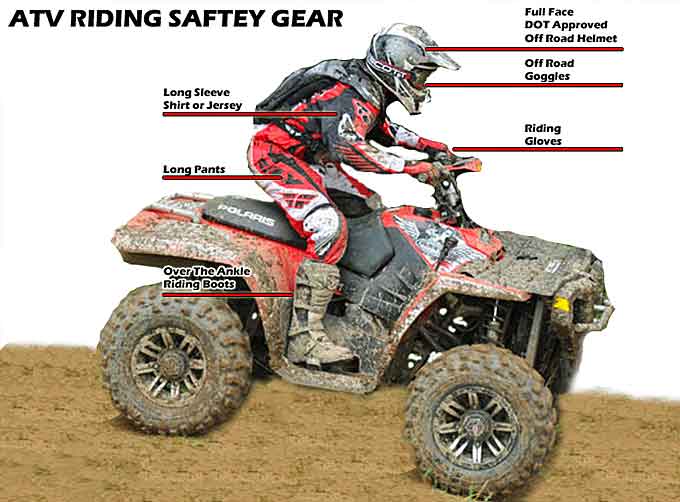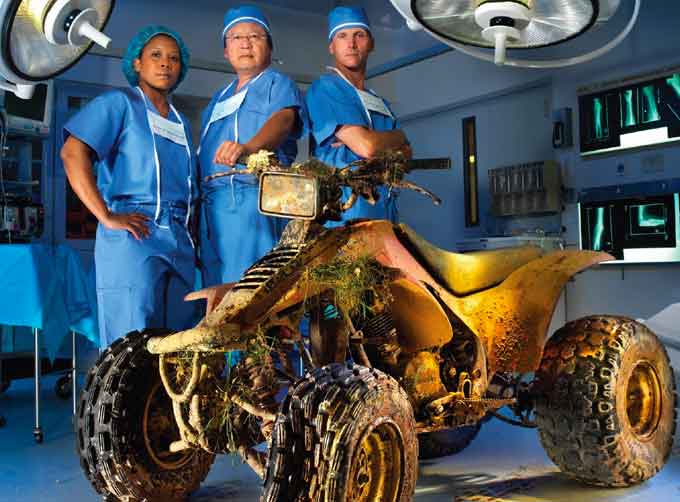
A new research article was published on September 15, 2018 in the Journal of the American Academy of Orthopaedic Surgeons analyzes the impact of an American Academy of Orthopaedic Surgeons’ (AAOS) All-Terrain Vehicle (ATV) public safety campaign and implications for future efforts to reduce injuries.
According to Consumer Product Safety Commission (CPSC) data, ATV injuries led to more than 2 million emergency department visits from 2000 to 2015.
ATV accidents can lead to traumatic brain injuries, skull fractures, concussions, spinal fractures, and broken bones.
“While the AAOS campaign, and various other public safety campaigns have had a visible impact on ATV related injuries, more needs to be done,” said Joey Johnson, MD, an orthopedic surgeon and an author of the article titled, “Trends in all-terrain vehicle injuries from 2000 to 2015 and the effect of targeted public safety campaigns.”

“In 2015, ATV accidents were responsible for over 108,000 emergency room visits, and while this is a decline from the peak volume of injuries in 2007, it’s actually the same rate as 2000.”
Orthopedic surgeons treat many of the patients who land in emergency rooms after ATV accidents.
Looking for a way to stem the flow of injuries, AAOS launched a multimedia campaign highlighting the risk of injury in young and inexperienced drivers in 2007.
Study authors reviewed the rates of ATV-related injuries and identified trends before and after the campaign and highlighted the following findings:
-
There was an upward trend in the injury rate from 2000, when the injury rate was 36 per 100,000 people through 2007, when it peaked at 54 per 100,000.
-
ATV injuries decreased 34 percent from 2007 to 2015.
-
In 2015, the rate of injuries was 34 per 100,000 people.
-
Total estimated ATV injuries according to CPSC data:
- 2000: 102,425 injuries.
- 2007: 163,114 injuries.
- 2015: 108,220 injuries.
- The total number for 2015 is slightly higher than 2000, but when corrected for population and ER visits, it ends up being nearly the same rate.
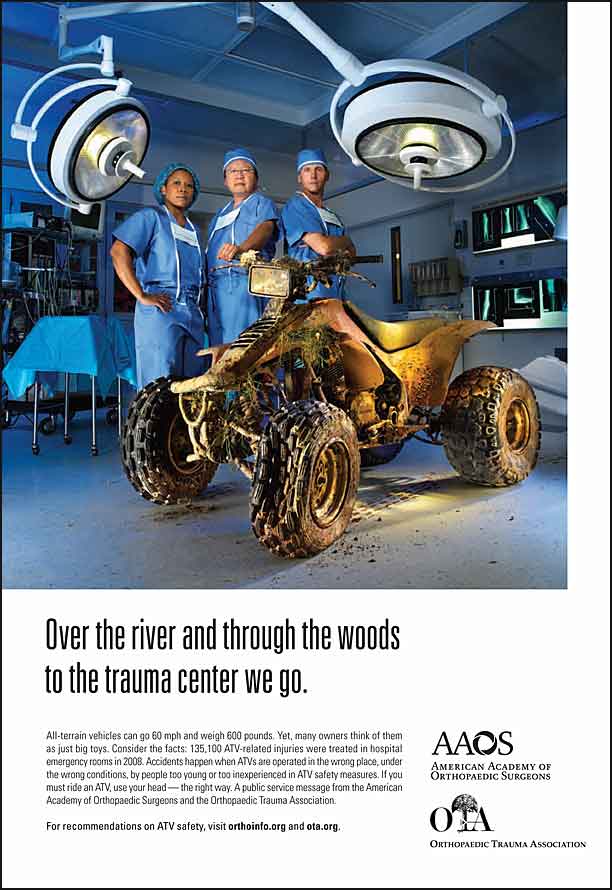
The overall incidence of ATV-related injuries has declined since 2007, which coincides with the launch of AAOS’ public service campaign.
The authors initially hypothesized that ATV injury rates decreased more quickly than similar products, such as dirt bikes, due to differences in media exposure.
However, the decrease in injuries was similar for both vehicles.
“Most likely, multiple factors helped drive the decrease in the rate of ATV injuries, with the AAOS and other public safety campaigns potentially playing a role,” said Dr. Johnson.
Risk for ATV injury varies by age, gender, experience and state of the rider, and helmet use.
“Children ages 14 to 17 years are at nearly three times greater risk than the national average to sustain ATV-related injuries,” noted Dr. Johnson.
ATVs are especially dangerous for children.
From 1982-2016, children under 16 years of age accounted for an estimated 22 percent of total ATV-related deaths.
Injuries were 2.7 times more common in males than females.
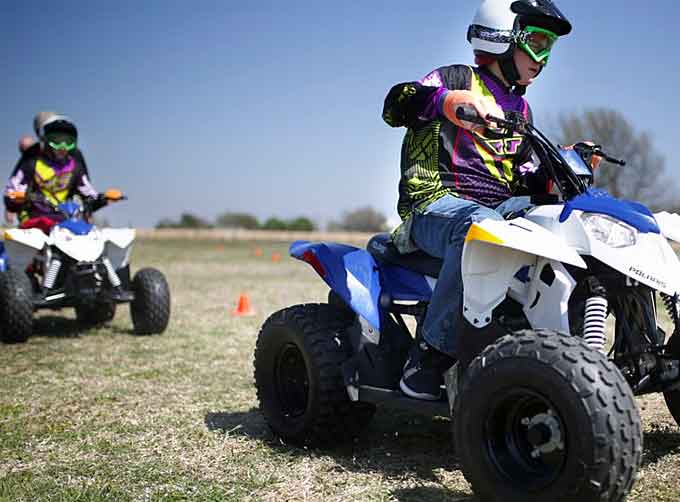 Inexperience, intoxication, and failure to wear a helmet all increase injury risk.
Inexperience, intoxication, and failure to wear a helmet all increase injury risk.
Johnson points to safety campaigns as well as legislation as key to keeping riders safe. There are currently no national standards for ATV safety, and state regulations vary significantly.
For example, 8-year-olds may operate ATVs in North Carolina, while in many states 14 is the minimum age.
While AAOS, American Academy of Pediatrics (AAP), and the CPSC all discourage ATV use in children 16 years or younger, those are only voluntary guidelines.
“Given the serious morbidity associated with these injuries, the cost to the healthcare system to treat them, and that the population most at risk appears to be children and adolescents, further safety initiatives and uniform legislation regarding ATV use are needed,” Dr. Johnson asserted.
“We need to reach teens and parents in rural, urban and suburban areas.”
“It’s critical that we help them understand that learning how to ride safely at an appropriate age, wearing helmets, and not being intoxicated can prevent life-changing injuries.”
To view the full study please visit here.
A Public Health Risk
Orthopedic injuries, including broken arms and legs, dislocated hips, and foot amputations, are common after ATV accidents. Head injuries are also common and are the leading cause of death.
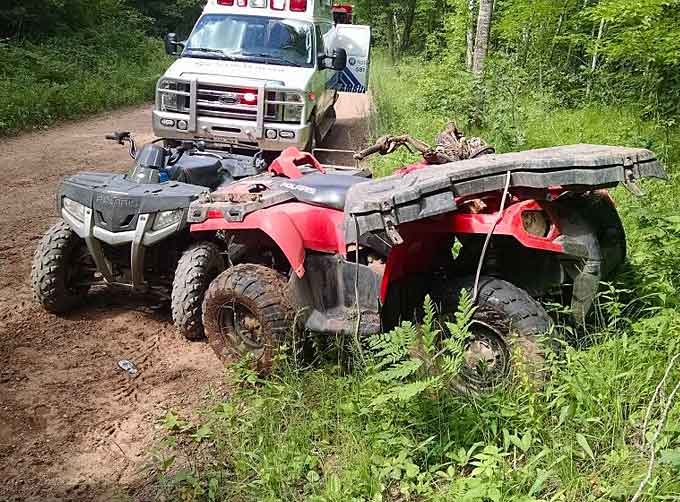
Many injuries occur when an ATV rolls over, landing on the operator or passenger.
Other injuries result when an operator loses control of an ATV, is thrown or falls from an ATV, or collides with another vehicle or a fixed object, such as a tree.
Driver inexperience, excessive speed, lack of helmet use, and intoxication are all risk factors for injury.
Because of their inherent danger, the AAOS considers ATVs to be a significant public health risk.
To help reduce the numbers of injuries and deaths, particularly among young people, AAOS—along with the Orthopaedic Trauma Association (OTA), and the Pediatric Orthopaedic Society of North America (POSNA)—recommends that:
-
All ATV operators should be licensed and undergo a hands-on training course.
- Both children and adults should be able to demonstrate competence in handling the vehicle and knowledge of the potential safety hazards.
-
ATVs should never be driven by a child younger than the age of 12.
- Younger children do not have adequate physical size and strength to control these vehicles.
- Nor do they have the motor skills, coordination, and judgment needed to operate a vehicle safely.
- Children between the ages of 12 and 16 should have limitations on their use of ATVs. They should be supervised by a responsible adult.
- Children under 16 years of age should only operate age-appropriate models that have an engine size of 90 cc or less.
-
Operators should always wear protective gear.
- Helmets are especially important in reducing the risk of head injury.
- Wearing protective gloves, goggles, heavy boots, and long pants can also help reduce injuries.
-
ATVs should only be used during daylight hours.
- In the varied terrain in which ATVs are most commonly used, good visibility is required.
- Riding after dark is especially dangerous.
- The lights attached to an ATV cannot provide enough properly directed illumination when the vehicle is bouncing or turning.
-
Only one person should ride a vehicle intended for single person use.
- Adding a passenger increases the likelihood that the ATV will tip or turn over.
-
Do not operate an ATV if you have taken drugs or alcohol.
- A large number of ATV-related fatalities involve alcohol use.
AAOS Safety Tips
Here are some additional safety tips for ATV use.
Following these guidelines could help reduce your risk of injury.
-
Read all instruction manuals and follow the manufacturers’ recommendations for use, maintenance, and pre-use checks.
-
Do not operate an ATV at excessive speeds.
-
- With their narrow wheel base and high center of gravity, ATVs are unstable and can easily flip when traveling at a high rate of speed on uneven ground.
- Except under very specific circumstances, in most areas it is illegal to operate off-road vehicles on public roads and highways.
- Check your local laws to determine whether you are able to operate your ATV on public roads and, if so, always obey the rules of the road.













